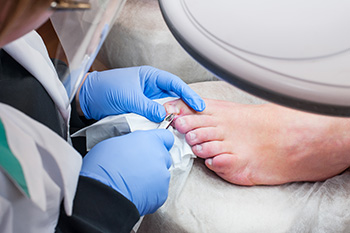
An ingrown toenail occurs when the edge of the nail grows into the surrounding skin, often resulting in pain, redness, swelling, and sometimes infection. It may appear inflamed, feel tender to the touch, and may produce drainage, if infected. Contributing factors include improper nail trimming, wearing ill-fitting footwear, or trauma to the toe. Podiatrists treat ingrown toenails using various methods, including partial or full nail removal, topical or oral antibiotics, and, in some cases, a surgical procedure to permanently prevent regrowth of the problematic portion of the nail. Following surgical treatment, it is important to follow your podiatrist’s postoperative instructions carefully. This typically includes keeping the foot clean and dry and avoiding strenuous activity for up to two weeks, or as advised. Wearing open-toed or loose-fitting shoes helps to reduce pressure on the healing toe. Your podiatrist will provide guidance on proper nail care to prevent recurrence, such as trimming nails straight across and avoiding wearing overly tight footwear. It is suggested that you contact your podiatrist promptly if you experience increased pain, redness, swelling, drainage, or signs of fever post-surgery.
Ingrown toenails can become painful if they are not treated properly. For more information about ingrown toenails, contact Bryan Sullivan, DPM of Mississippi Foot Center . Our doctor can provide the care you need to keep you pain-free and on your feet.
Ingrown Toenails
Ingrown toenails occur when a toenail grows sideways into the bed of the nail, causing pain, swelling, and possibly infection.
Causes
- Bacterial infections
- Improper nail cutting such as cutting it too short or not straight across
- Trauma to the toe, such as stubbing, which causes the nail to grow back irregularly
- Ill-fitting shoes that bunch the toes too close together
- Genetic predisposition
Prevention
Because ingrown toenails are not something found outside of shoe-wearing cultures, going barefoot as often as possible will decrease the likeliness of developing ingrown toenails. Wearing proper fitting shoes and using proper cutting techniques will also help decrease your risk of developing ingrown toenails.
Treatment
Ingrown toenails are a very treatable foot condition. In minor cases, soaking the affected area in salt or antibacterial soaps will not only help with the ingrown nail itself, but also help prevent any infections from occurring. In more severe cases, surgery is an option. In either case, speaking to your podiatrist about this condition will help you get a better understanding of specific treatment options that are right for you.
If you have any questions, please feel free to contact our office located in Jackson, MS . We offer the newest diagnostic and treatment technologies for all your foot care needs.
